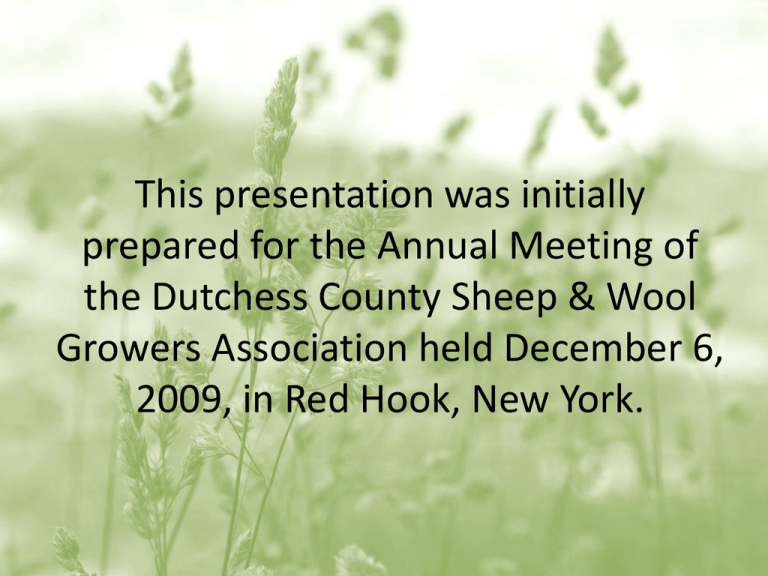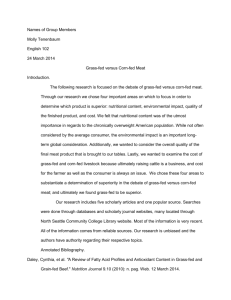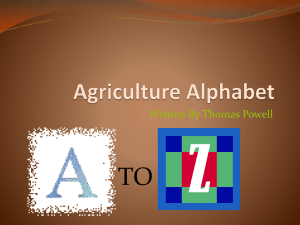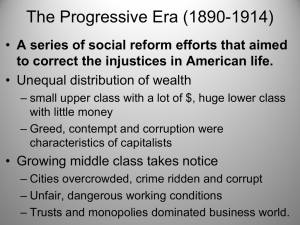Grass-fed lamb and goat
advertisement

This presentation was initially prepared for the Annual Meeting of the Dutchess County Sheep & Wool Growers Association held December 6, 2009, in Red Hook, New York. Grass-fed Pros and cons, myths and truths, whys and why nots SUSAN SCHOENIAN Sheep & Goat Specialist Western Maryland Research & Education Center University of Maryland Extension sschoen@umd.edu – www.sheepandgoat.com 60 bucks The Baalands www.baalands.com 45 ewes Western Maryland Pasture-Based Meat Goat Performance Test mdgoattest.blogspot.com Grass-fed meat, milk, and fiber 1) There is an increasing demand for grass-fed meat, milk, and fiber. 2) There are perceptions that grass-fed meat and milk are healthier. Grass-fed meat, milk, and fiber 3) There are perceptions that grass-based systems improve animal welfare. 4) There are perceptions that grass-based systems are better for the environment and leave a smaller carbon footprint. 5) Some people claim that grass-fed meat tastes better. 1) There is an increasing demand for grass-fed meat, milk, and fiber. Demand for grass-fed meat • Imported lamb from New Zealand and Australia is grass-fed and already comprises a significant portion of the domestic market. • No hard data to support an increase in demand for grass-fed lamb and goat. ↑ Growing niche market. 2) The meat and milk produced from grass-fed livestock is healthier than the meat and milk from livestock that are fed grain-based diets. Meat characteristics a) Fatty acids i. Omega-3 vs. (n-3) omega-6 (n-6) ii. Conjugated linoleic acid (CLA) b) Vitamins c) E. coli 0157:H7 Omega fatty acids Omega-3 Omega-6 • Unsaturated essential fatty acids that have a double carbon bond in the third “n-3” position. • Richest sources: seafood, some green vegetables, some vegetable oils, some nuts. • Should lower the cooking temperature and cook for longer. • Unsaturated essential fatty acids that have a double carbon bond in the sixth “n=6” position. • Richest sources: safflower, corn, cottonseed and soybean oils. • Can be cooked at higher temperatures. An imbalance (>4:1) in the consumption of omega fatty acids is believed to contribute to many health problems: cardiovascular disease, obesity, diabetes, cancer, etc. Dietary effect on fatty acids Grass-fed • Higher levels of Omega-3 Grain-based diet • Higher levels of Omega-6 But, it’s not that simple. • Species differences • Individual differences • Other dietary sources can increase amount of omega-3 fatty acids in meat and milk. – Fish and algae oil – Linseed (flax) supplementation Conjugated linoleic Acid (CLA) • Polyunsaturated fat found in the meat and milk of ruminant livestock. – Rumen bacteria are key to the formation of CLA. • The “good” fat – Anti-cancer – Anti-oxidant – Anti-obesity • Discovered in 1979 by researchers at the University of Wisconsin. Conjugated linoleic Acid (CLA) Goat meat ? http://www.das.psu.edu/research-extension/dairy/nutrition/pdf/das0488cla.pdf/ Conjugated linoleic Acid (CLA) • There is a large variation in the CLA content of meat and milk. 1) Diet 2) Animal 3) Post-harvest Dietary effects 1) Grazing – – Forages differ in their fatty acid content Lush pasture > mature pasture 2) Supplementing total mixed rations with plant oil or oil seeds. – Sunflower – Soybean Linseed (flax) 3) Supplementing total mixed rations with fish oil. Animal factors • Within and between breeds variation – Meat – Milk E. Coli 0157:H7 • Acid resistant E. coli that is common in beef cattle and can cause food-borne illness in people. • A grain-based diet causes higher shedding of e. coli in the manure • Other control methods – – – – – Pre-harvest diet Probiotics Vaccination HACCP Safe food handling 3) There are perceptions that grassbased systems provide a higher degree of animal welfare. Animal health and welfare Grazing - forage feeding More natural environment. More natural diet. Greater predator risk. More exposed to elements. More susceptible to internal parasites (worms). More susceptible to bloat, plant poisons and toxins. Nutrition can be a limiting factor. Confinement - concentrate feeding Less opportunity to express natural behavior. Less natural diet. More susceptible to overeating disease, acidosis, urinary calculi, polio, and pneumonia. More tolerant of internal parasites (worms) Better protection from weather extremes and predators. Easier to monitor animal health and performance. Animal welfare and health Animal welfare is not achieved by choosing a particular production or feeding system, it is a standard of management and commitment to animal welfare. 4) There are perceptions that grass-based systems are better for the environment and leave a smaller carbon footprint Environmental benefits of well-managed grazing • • • • • Vegetative cover Reduced soil erosion Improve soil quality Better plant diversity Improved wildlife and fish habitat • Improved water and air quality • Reduced runoff • More even manure distribution. Modern vs. 1940’s style grass-based dairy Inputs • 21 percent of cows • 23 percent of feedstuffs • 35 percent of water • 10 percent of land Outputs • 24 percent of manure • 37 percent of carbon footprint http://jas.fass.org/cgi/content/full/87/6/2160 Corn vs. pasture-fed beef http://wsu.academia.edu/documents/0046/7264/2009_Cornell_Nutrition_Conference_Capper_et_al.pdf Production efficiency (management + technology) = Low carbon footprint 5) Some people claim that grass-fed meat tastes better. Lamb flavor Almost all lambs grade USDA Choice or higher. Grass-fed More intense lamb flavor More off flavors, “gamey” More off odors PUFAs very susceptible to oxidation during cooking. Grain-fed or grass + grain Milder flavor Less off flavors Less odor In the U.S. American lamb (grainfed) has usually been preferred to New Zealand lamb (grass-fed). Taste panel results depend upon personal preference and previous exposure to lamb. Profitable forage-based finishing systems • High quality forages • Alternative forages to fill gaps in perennial forage production and/or promote higher rates of gain. • Optimal stocking rates • Low input costs • Premium prices for products. What you can’t or shouldn’t say • Make unsubstantiated nutritional claims – Higher in omega-3 fatty acids – Higher in conjugated linoleic acid – Higher in fat and water-soluble vitamins • Hormone-free That conventionally-produced meat and milk is “bad” for health, animal welfare, or the environment. • It’s not true • We’re all in this together What you should say instead • What you feed your livestock • How you raise your livestock • That your products are locally-produced or certify your products as • USDA Organic • USDA Naturally raised USDA Grass (forage) fed • Humanely raised and handled • Sustainably produced USDA’s grass-fed marketing claim For ruminants and ruminant-derived products • Grass and forage shall be the feed source consumed for the lifetime of the ruminant animal, with the exception of milk consumed prior to weaning. • The diet shall be derived solely from forage consisting of grass (annual and perennial), forbs (e.g.,legumes, Brassica), browse, or cereal grain crops in the vegetative (pregrain) state. USDA’s grass-fed marketing claim For ruminants and ruminant-derived products • Animals cannot be fed grain or grain byproducts and must have continuous access to pasture during the growing season (last to first frost). • Hay, haylage, baleage, silage, crop residue without grain, and other roughage sources may also be included as acceptable feed sources. USDA’s grass-fed marketing claim For ruminants and ruminant-derived products • Routine mineral and vitamin supplementation may also be included in the feeding regimen. • Incidental supplementation must be fully documented. USDA’s grass-fed marketing claim For ruminants and ruminant-derived products • Permitted – Antibiotics – Growth promotants There is no one production system that will be profitable, competitive, and sustainable for everyone. 1) Identify long-term goals. 2) Fully utilize resources. 3) Be willing to change the system when either goals or resources change. Thank you for your attention www.sheepandgoat.com www.sheep101.info mdsheepgoat.blogspot.com








